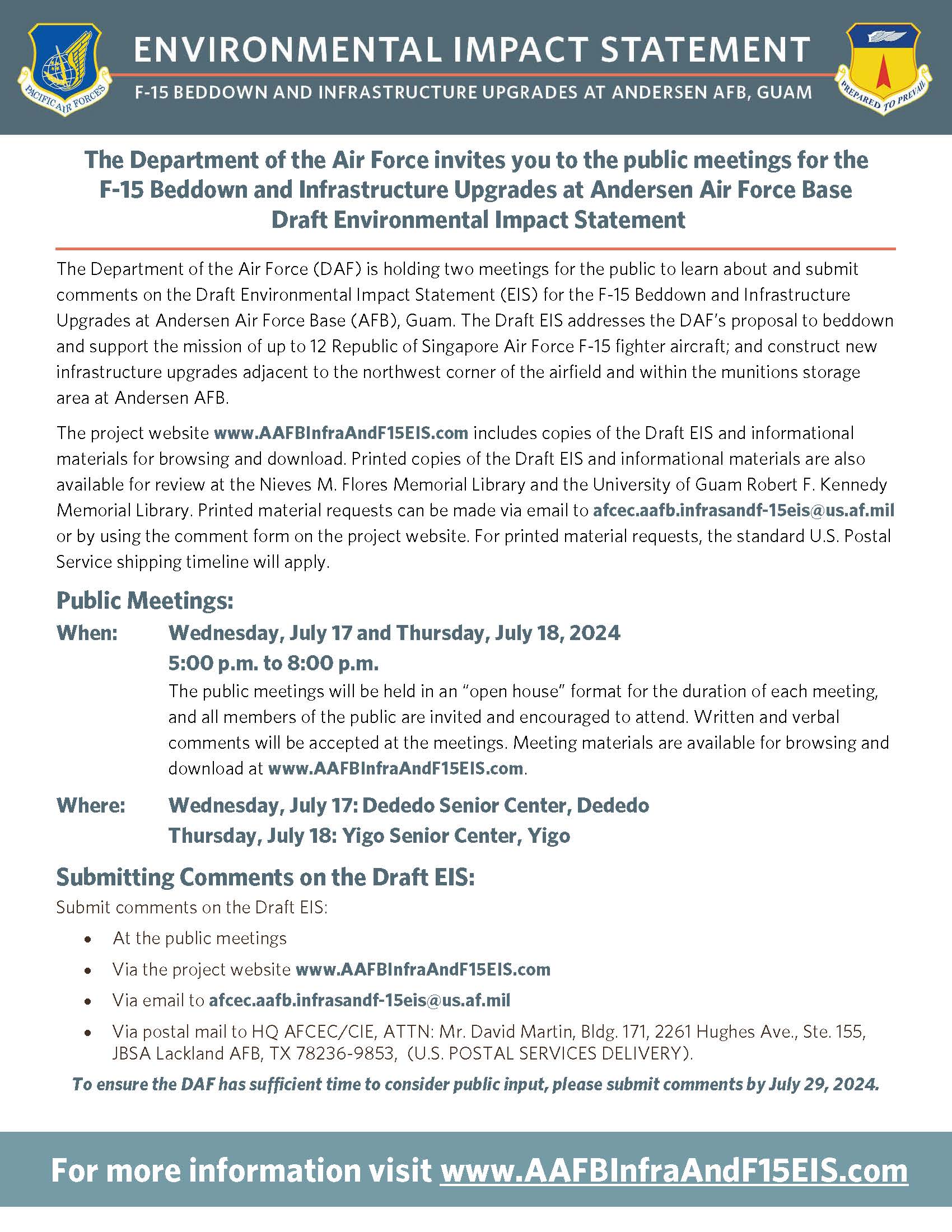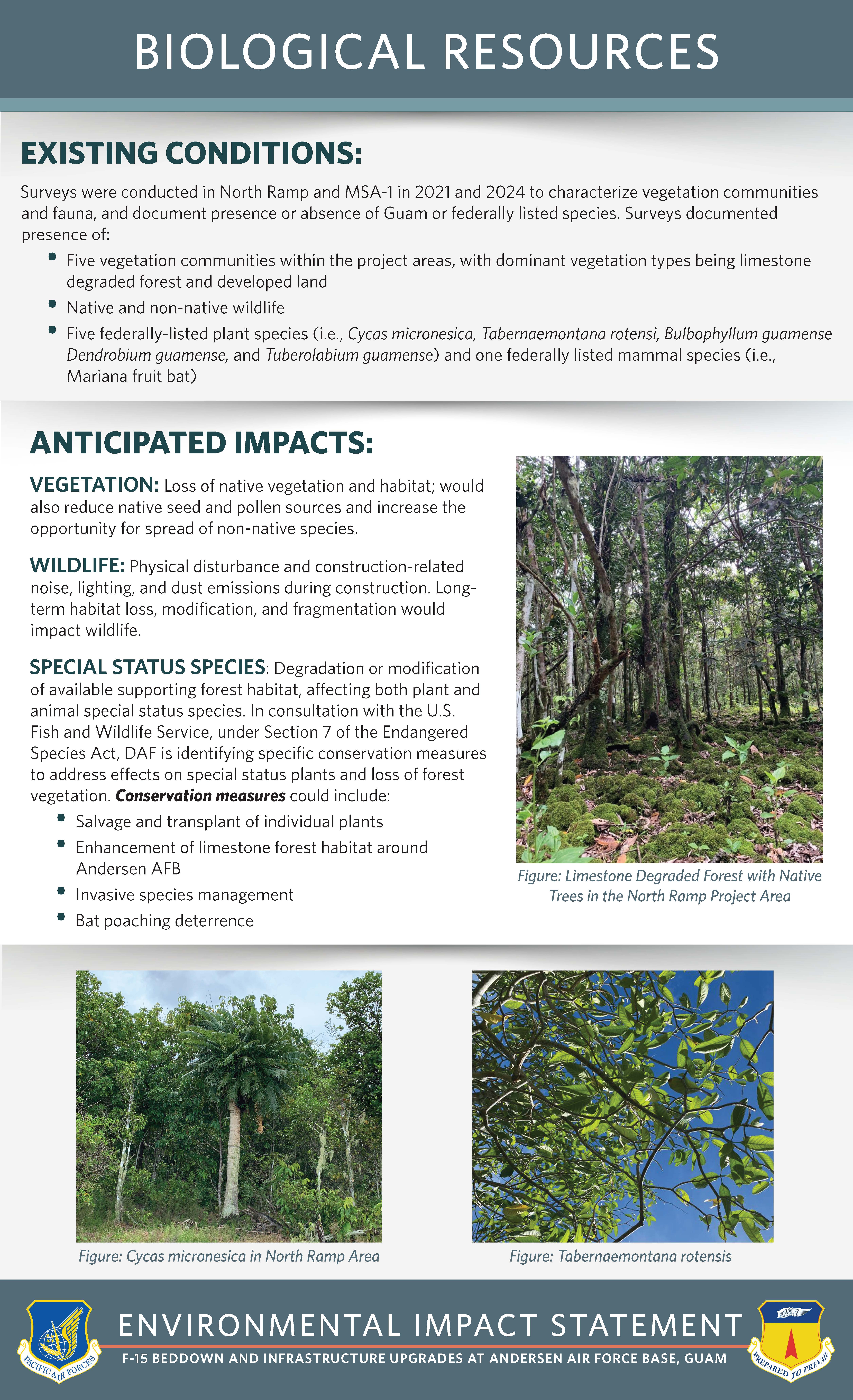AAFB Infrastructure EIS
The Department of the Air Force (DAF) published a Notice of Availability for the Draft Environmental Impact Statement (EIS) in the Federal Register on June 14, 2024 and held a 45-day public review period for the Draft EIS, which ended on July 29, 2024. All comments received during the public review period for the Draft EIS are being considered in preparation of the Final EIS, and substantive comments will be addressed in the Final EIS. The Final EIS is anticipated in Spring 2025. Additional information on the Draft EIS Public Review Period that was conducted is provided on this page below.
Draft EIS Public Review Period
The DAF conducted a public review period, beginning on June 14, 2024 and ending on July 29, 2024, in accordance with the National Environmental Policy Act (NEPA) and the Council on Environmental Quality's NEPA regulations (40 Code of Federal Regulations 1500-1508).
The DAF requested comments from local and federal agencies, political stakeholders, and interested members of the public and held two public meetings, one in Dededo and one in Yigo, to provide the public with the opportunity to learn more about the proposal and provide input. The public meetings were held in an “open house” format for the duration of each meeting, and all members of the public were invited and encouraged to attend. Written and verbal comments were accepted at the meetings.
Materials prepared for the public review period are included here and are still available for download on the Resources page of this website for the duration of the project. The Draft EIS was also available for review at the following libraries: Nieves M. Flores Memorial Library, 254 Martyr Street, Hagåtña, GU 96910; and University of Guam Robert F. Kennedy Memorial Library, Government Documents, Tan Siu Lin Building, UOG Station, 303 University Drive, Mangilao, GU 96923.
Topic #1 - The National Environmental Policy Act
The National Environmental Policy Act
Background
The National Environmental Policy Act (NEPA) of 1969 was enacted to address concerns about federal actions and their effects on the environment.
NEPA’s main objectives are as follows:
- Ensure analysis of proposed federal programs, projects, and actions before decision-making
- Inform the public of proposed federal activities that might affect environmental quality
- Encourage and facilitate public involvement in the decision-making process
What is an EIS?
An Environmental Impact Statement (EIS) is the most detailed analysis prescribed by the regulations implementing NEPA.
An EIS is a detailed public document describing:
- A proposed action
- All alternative actions that were considered
- Environmental impacts of implementing the proposed action and reasonable alternatives
Steps in the EIS Process
- Notice of Intent published
- Public scoping period
- Preparation of Draft EIS
- Notice of Availability (NOA) for Draft EIS published
- Draft EIS comment period and public meetings
- Preparation of Final EIS
- NOA for Final EIS published
- Waiting period (30 days)
- Record of Decision
Topic #2 - Public Review Period
Public Review Period
What is the Public Review Period?
- A public review period is conducted to provide the public with the opportunity to review and comment on a Draft Environmental Impact Statement (EIS), in compliance with the National Environmental Policy Act (NEPA). The Draft EIS contains information on the action being proposed, and presents potential impacts from implementing the proposed action and alternatives.
- During the public review period, the Department of the Air Force (DAF) actively requests substantive public comments on topics addressed in the Draft EIS for consideration in the Final EIS.
The DAF has published a Notice of Availability in the Federal Register for the Draft EIS for the F-15 Beddown and Infrastructure Upgrades at Andersen Air Force Base (AFB), Guam. The DAF is the lead agency for the EIS and the Department of the Navy is a cooperating agency.
What Happens After the Public Review Period Has Ended?
After the public review period has ended, the DAF will consider the comments received in the preparation of the Final EIS. All comments received within the public review period for the Draft EIS will be considered, and substantive comments will be responded to in the Final EIS. The DAF considers a comment to be substantive if it:
- Provides additional or new information that is relevant to the EIS.
- Presents other reasonable alternatives or components to the project, provided that a rational basis for consideration of the alternative or component is included.
- Questions the accuracy or adequacy of the information presented in the Draft EIS, provided that a rational basis for the question is included.
The Final EIS and a Record of Decision on the Proposed Action are expected in Spring 2025. A Record of Decision could be signed no sooner than 30 days after the Final EIS is released.
Topic #3 - Proposed Action Overview
Proposed Action Overview
Project Background
- Department of the Air Force (DAF) and Department of Defense (DoD) strategies and initiatives for the Indo-Pacific are continuously evolving in response to the geopolitical climate.
- Conducting an F-15 beddown and improving operationally relevant infrastructure with DAF and DoD initiatives to modernize and strengthen DoD's presence, improve logistics and maintenance capabilities, and allow the DAF and DoD to maintain agile defense capabilities within the region, in accordance with DAF responsibilities mandated by Title 10 U.S. Code 8062 to ensure readiness.
Purpose and Need
- Purpose: The purpose of the Proposed Action is to provide critical infrastructure that enhances U.S. posture west of the International Date Line. Additionally, the purpose of the Proposed Action is to beddown and operate Republic of Singapore Air Force (RSAF) fighter aircraft at Andersen Air Force Base (AFB) to support training requirements.
- Need: The Proposed Action is needed to enhance DAF capability to support U.S. and partner nation forces within the Indo-Pacific region and strengthen the U.S.'s ability to respond regionally and worldwide, through construction of infrastructure upgrades and increased support of fighter aircraft, in alignment with evolving DAF and DoD strategies and initiatives for the region. Increasing and improving infrastructure would address capability gaps and allow for greater efficiencies and agility in the way ground operations are conducted.
General Description of the Proposed Action
- Beddown up to 12 RSAF F-15 fighter aircraft with anticipated arrival in 2029, to include airfield operations and a 3 percent increase in installation personnel, which would strengthen partner national alliances.
- Construct infrastructure upgrades over approximately 3 to 7 years adjacent to the northwest corner of the airfield (North Ramp) and within Munitions Storage Area 1 (MSA-1) at Andersen AFB (Figure 1). Would provide additional options for parking, storing, maintaining, refueling, loading, and unloading aircraft at the airfield, as well as storing munitions, which would address capability gaps and allow for greater efficiencies and agility in the way ground operations are conducted. The proposed infrastructure has multiple uses and could support both the F-15 beddown and other DAF, service component, and partner nation aircraft or missions operating from Andersen AFB now or in the future.

Figure 1: Overview of Locations on Andersen AFB Selected for Infrastructure Upgrades
Alternatives Consideration
The DAF reviewed requirements for strategic capabilities within the Indo-Pacific region and dismissed five other potential alternative locations within the Pacific Air Forces area of responsibility (i.e., Iwo To [formerly known as Iwo Jima], Japan; Saipan, U.S.; Diego Garcia, British Indian Ocean Territory; Wake Island, U.S.; and Hawai‘i, U.S.) from consideration. Once Andersen AFB was identified for enhanced strategic capabilities, the DAF considered multiple locations on Andersen AFB for construction of infrastructure upgrades, and considered renovation or replacement of existing infrastructure. Only the Proposed Action was determined to meet the selection standards for infrastructure upgrades. The Draft EIS also analyzes a No Action Alternative, in addition to the Proposed Action.
Topic #4 - Proposed Action: Infrastructure Upgrades
Proposed Action: Infrastructure Upgrades
Proposed Action:
North Ramp Infrastructure
Approximately 80 acres of paved surfaces; 16 acres of stormwater management infrastructure; and 96 acres that would be cleared, graded, revegetated, and maintained.
- Airfield pavements
- Aircraft hangar and maintenance facility
- Flightline maintenance facility and utility building
- Jet fuel receipt, storage, and distribution system extension
- Fencing and utilities extensions
- Roadways and parking
- Stormwater management infrastructure
Figure 1: Proposed North Ramp
Infrastructure Upgrades

Proposed Action:
Munitions Storage Area-1 Infrastructure:
Approximately 2 acres of paved surfaces; 1.5 acres of stormwater management infrastructure; 2.3 acres of temporary disturbance to support construction; and 11.2 acres that would be cleared, revegetated, and maintained.
- Three earth-covered magazines
- Pavements and utility extensions
- Generator
- Stormwater management infrastructure
Figure 2: Proposed MSA-1 Infra-
structure Upgrades
Topic #5 - Proposed Action: F-15 Beddown
Proposed Action:
F-15 Beddown:
- Aircraft: Beddown of up to 12 Republic of Singapore (RSAF) F-15 fighter aircraft with anticipated arrival in 2029
- Operations: F-15 aircraft operations (i.e., flight operations that include a takeoff and landing) from Andersen Air Force Base (AFB), to include hosting periodic, temporary aircraft in support of the training mission requirements for the F-15s
- Each training event would include an additional 12 F-15s (i.e., total of 24 F-15s per training event), 1 tanker/refueling aircraft (e.g., KC-135, KC-46, A-330), and 1 early warning aircraft (e.g., G-550).
- Training events with these additional aircraft would begin in 2030, after the F-15 beddown action is complete, and would occur for four weeks per event, twice per year.
- No new airspace is proposed and no changes to the manner in which the existing airspace is used would occur.
- Personnel: Increase in 240 personnel at the installation, concurrent with the 2029 beddown, to conform to squadron mission requirements. During each four-week training event, which would occur twice per year, an additional approximately 200 personnel would be required for the duration of the event.
Topic #6 - Impacts Analysis
Impacts Analysis
The following topics were analyzed in the Environmental Impact Statement (EIS):
Biological Resources
- Threatened and endangered species
- Essential fish habitat
- Wildlife and vegetation
- Wetlands and floodplains
Cultural Resources
- Archaeological resources (prehistoric and historic)
- Historic and architectural resources
Water Resources
- Water quality (surface water and stormwater)
- Groundwater aquifers
Social Resources
- Land use, including coastal zone management
- Socioeconomics and environmental justice
- Recreation
- Health and safety
Other Considerations
- Geology and soils
- Infrastructure and utilities
- Noise
- Air quality
- Transportation
- Hazardous materials and waste
Summary of Impact Analysis
The Department of the Air Force conducted cultural and natural resources surveys in the areas proposed for upgrades and is consulting with appropriate resource agencies to determine the potential for significant impacts on those resources and corresponding mitigation measures, as needed. It is not expected that the Proposed Action would have significant impacts on other topics analyzed in the Draft EIS.
Topic #7 - Submit Comments
Submit Comments
Comments, questions, and relevant information are welcomed on the Department of the Air Force’s (DAF) Draft Environmental Impact Statement (EIS) for the F-15 Beddown and Infrastructure Upgrades at Andersen Air Force Base (AFB), Guam. The DAF also welcomes comments under Section 106 of the National Historic Preservation Act (36 CFR 800) regarding the identification of or effects on historic properties. Please submit comments in English using one of the following methods:
- Postal Mail:
HQ AFCEC/CIE
ATTN: Mr. David Martin
Bldg. 171, 2261 Hughes Ave., Ste. 155
JBSA Lacklan AFB, TX 78236-9853
(U.S.) POSTAL SERVICES DELIVERY)
- Email:
afcec.aafb.infrasandf-15eis@us.af.mil
Attn: AAFB F-15 and Infrastructure EIS
- Project Website:
www.AAFBInfraAndF15EIS.com
- Public Meetings:
Verbal and written comments are being accepted at both public meetings.
The Draft EIS and associated public materials are available on the project website for browsing or download. Requests for printed materials can be made using the methods above. For printed materials, the standard U.S. Postal Service shipping timeline will apply. Please consider the environment before requesting printed material.
To ensure the DAF has sufficient time to consider public input, please submit comments by July 29, 2024.
Thank you for your participation in the Draft EIS public review period for the F-15 Beddown and Infrastructure Upgrades at Andersen AFB!
Topic #8 - Biological Resources
Biological Resources
Existing Conditions:
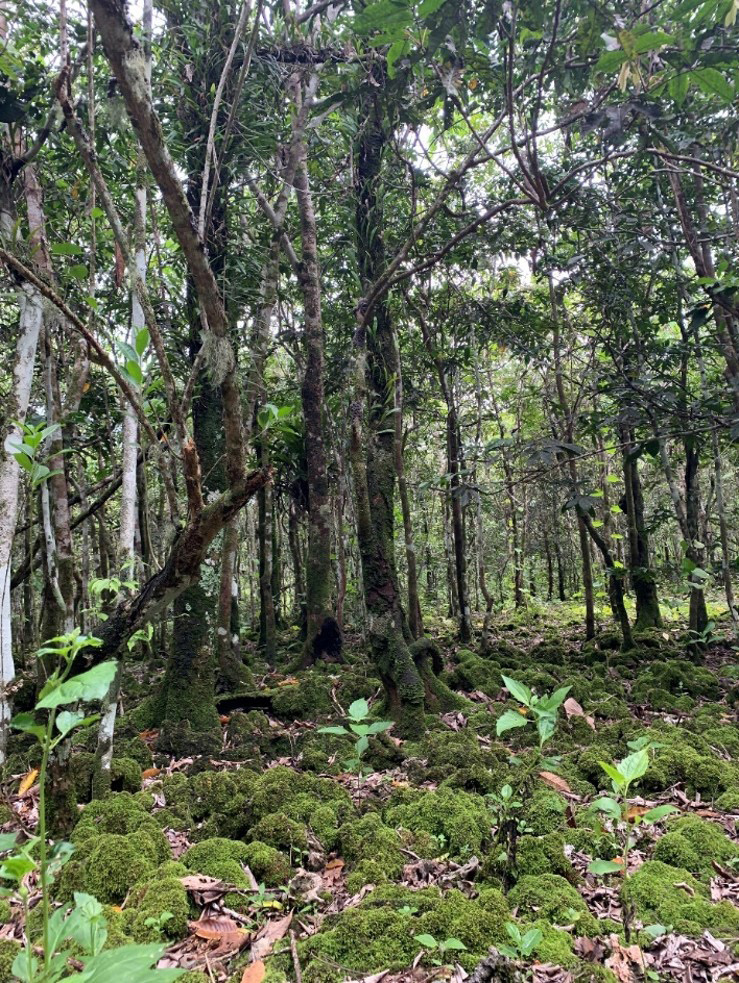 |
| Figure 1: Limestone Degraded Forest with Native Trees in the North Ramp Project Area |
Surveys were conducted in North Ramp and MSA-1 in 2021 and 2024 to characterizevegetation communities and fauna, and document presence or absence of Guam or federally listed species. Surveys documented presence of:
- Five vegetation communities within the project areas, with dominant vegetation types being limestone degraded forest and developed land
- Native and non-native wildlife
- Five federally-listed plant species (i.e., Cycas micronesica, Tabernaemontana rotensi, Bulbophyllum guamense, Dendrobium guamense, and Tuberolabium guamense) and one federally listed mammal species (i.e., Mariana fruit bat)
Anticipated Impacts:
Vegetation: Loss of native vegetation and habitat; would also reduce native seed and pollen sources and increase the opportunity for spread of non-native species.
Wildlife: Physical disturbance and construction-related noise, lighting, and dust emissions during construction. Long-term habitat loss, modification, and fragmentation would impact wildlife.
Special Status Species: Degradation or modification of available supporting forest habitat, affecting both plant and animal special status species. In consultation with the U.S. Fish and Wildlife Service, under Section 7 of the Endangered Species Act, DAF is identifying specific conervation measures to address effects on special status plants and loss of forest vegetation. Conservation measures could include:
- Salvage and transplant of individual plants
- Enhancement of limestone forest habitat around Andersen AFB
- Bat poaching deterrence
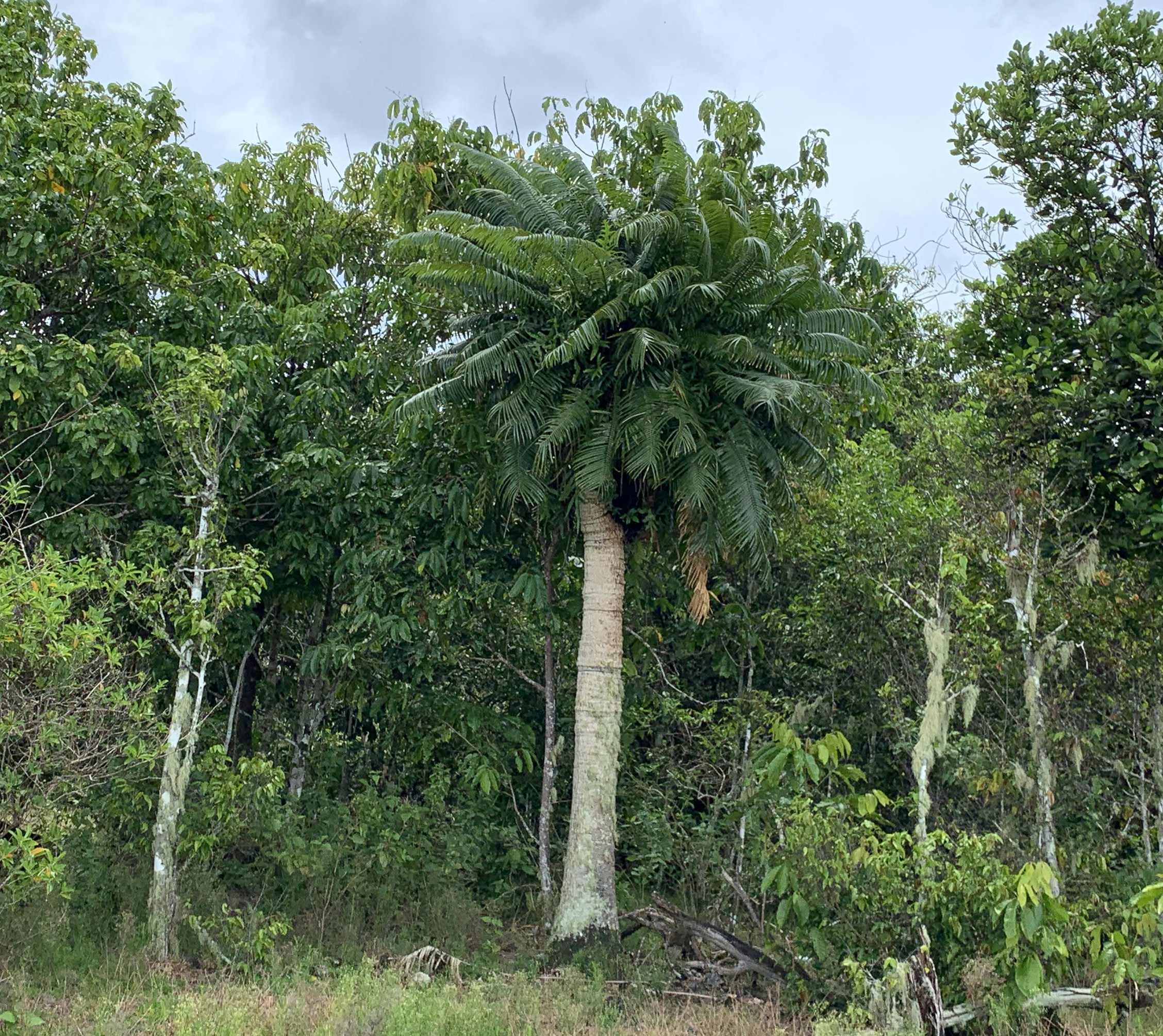 |
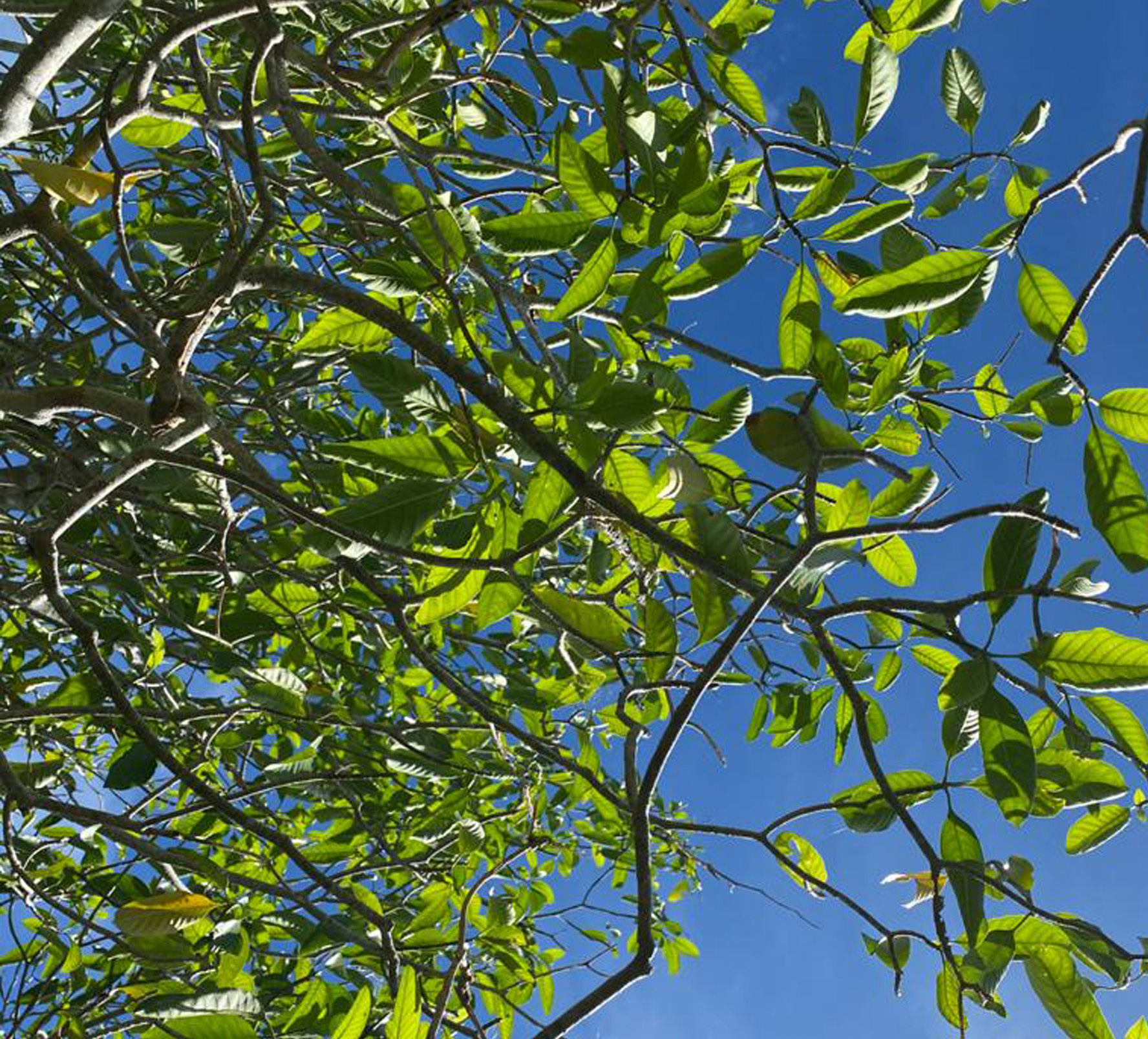 |
| Figure 2: Cycas micronesia in North Ramp Area |
Figure 3: Tabernaemontana rotensis |
Topic #9 - Noise
Noise
Existing Conditions:
- Existing sources of noise in the area include military and civilian aircraft overflights, aircraft ground activities, road traffic, and other noises such as lawn maintenance equipment and construction. The primary source of noise is aircraft operations.
- Approximately 486 acres off-Andersen AFB and 3,438 acres on-Andersen AFB are within the 65-dBA DNL contour, including approximately 85 residences.
- No off-Andersen AFB noise sensitive areas within the existing 65-dBA DNL contour, including schools, churches, or hospitals.
Anticipated Impacts:
- Approximately 569 acres off-Andersen AFB and 3,862 acres on-base would be within the 65-dBA DNL contour; and increase of approximately 83 off-Andersen AFB acres.
- Increase in approximately 40 residences within the 65-dBA DNL contour
- No off-Andersen AFB noise sensitive areas within the existing 65-dBA DNL contour, including schools, churches, or hospitals.
 |
| Figure: Aircraft Noise Contours for Andersen AFB with the Proposed Action |



